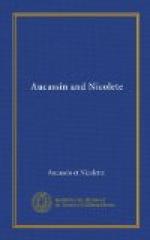Mr. Jamieson, in Illustrations of Northern Antiquities (p. 379), preserved a cante-fable called Rosmer Halfman, or The Merman Rosmer. Mr. Motherwell remarks (Minstrelsy, Glasgow, 1827, p. xv.): “Thus I have heard the ancient ballad of Young Beichan and Susy Pye dilated by a story-teller into a tale of remarkable dimensions—a paragraph of prose and then a screed of rhyme alternately given.” The example published by Mr. Motherwell gives us the very form of Aucassin and Nicolete, surviving in Scotch folk lore:-
“Well ye must know that in the Moor’s Castle, there was a mafsymore, which is a dark deep dungeon for keeping prisoners. It was twenty feet below the ground, and into this hole they closed poor Beichan. There he stood, night and day, up to his waist in puddle-water; but night or day it was all one to him, for no ae styme of light ever got in. So he lay there a lang and weary while, and thinking on his heavy weird, he made a murnfu’ sang to pass the time—and this was the sang that he made, and grat when he sang it, for he never thought of escaping from the mafsymore, or of seeing his ain countrie again:
“My hounds they all run masterless,
My hawks they flee from tree to
tree;
My youngest brother will heir my
lands,
And fair England again I’ll
never see.
“O were I free as I hae been,
And my ship swimming once more on
sea,
I’d turn my face to fair England,
And sail no more to a strange countrie.”
“Now the cruel Moor had a beautiful daughter called Susy Pye, who was accustomed to take a walk every morning in her garden, and as she was walking ae day she heard the sough o’ Beichan’s sang, coming as it were from below the ground.”
All this is clearly analogous in form no less than in matter to our cante-fable. Mr. Motherwell speaks of fabliaux, intended partly for recitation, and partly for being sung; but does not refer by name to Aucassin and Nicolete. If we may judge by analogy, then, the form of the cante-fable is probably an early artistic adaptation of a popular narrative method.
STOUR; an ungainly word enough, familiar in Scotch with the sense of wind-driven dust, it may be dust of battle. The French is Estor.
BIAUCAIRE, opposite Tarascon, also celebrated for its local hero, the deathless Tartarin. There is a great deal of learning about Biaucaire; probably the author of the cante-fable never saw the place, but he need not have thought it was on the sea-shore, as (p. 39) he seems to do. There he makes the people of Beaucaire set out to wreck a ship. Ships do not go up the Rhone, and get wrecked there, after escaping the perils of the deep.
On p. 42, the poet clearly thinks that Nicolete, after landing from her barque, had to travel a considerable distance before reaching Biaucaire. The fact is that the poet is perfectly reckless of geography, like him who wrote of the set-shore of Bohemia.




